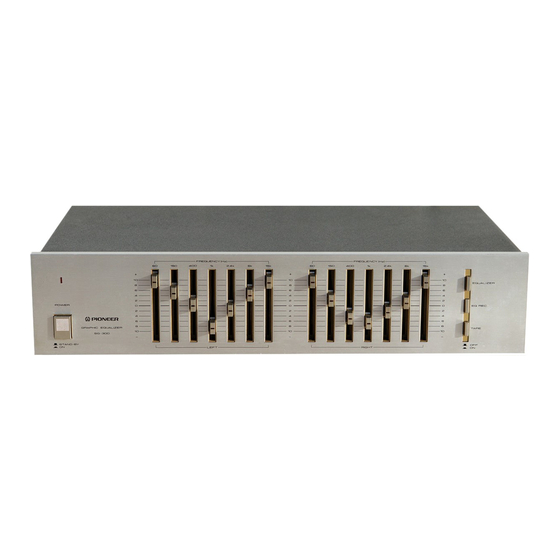
Advertisement
4. CIRCUIT DESCRIPTIONS
G R A P H I C E O U A L I Z E R S E C T I O N
A graphic equalizer is a device which divides the
audio frequency band into several segments called
octaves so that the level of each individual octave
can be increased or reduced. The SG-300 divides
reproduced frequencies into 7 octaves with center
frequencies of 60 Hz, 150 Hz, 4OO Hz, 1 kHz,
2.4kHz, 6 kHz and 15 kHz. The level of each
octave can be varied throughout arange of t10 dB,
and the left channel and the right channel can be
adjusted independently.
Further, when the equalizer switch (EQ SW) is
ON, the LEDs built into the level controls (sliding
variable resistor knobs) light to allow the fre-
quency response of each octave to be determined
visually. The equalizer element is an LC series
resonance circuit in which the active element is
an inductor equivalent. This resonance circuit is
connected to the variable resistor linking the
positive and negative input terminals. (See Figwe
4-L.',)
This causes the impedance of
the resonance
circuit and the resistance of the varirable resistor to
act as constants for the input circuit and the
feedback circuit.
Further, buffer amplifiers are
located before and after the EQ AMP so that the
frequency response of the equalizer element are
not affected by the impedance of audio equipment
connected to the SG-300.
Figure 4-1 shows the equivalent circuit for the
graphic equalizer section. In the area surrounded
by the dotted line, the circuit on the Q1 side of
point A is equivalent to an inductance and a
resistance connected in series. Any required re-
sonant frequency can be obtained by changing the
inductance and capacitance of the series resonance
circuit by varying CL, C2, Rg and R4. \{ith the
SG-300,
7
equalizer elements $'ith
different
resonance frequencies are included in one EQ
AMP, and each frequency segment can be adjusted
independently. The frequency response of each
octave is boosted when the slider of the variable
resistor is moved toward the minus input side (the
feedback input side) of EQ AMP ICl; conversely,
it is reduced when the slider is moved to the plus
side.
P O W E R S U P P L Y C I R C U I T
As is shown in Figure 4-2, two voltage (+11 V
and - 11.5 V) are supplied by the regulated po\Mer
supply of the graphic equalizer section. The LED
set in the knob of each sliding resistor is supplied
with stable cunent by Q23, so the light emitted
4,
by the LED is steady. Further, the load on Q18
and qzL
is light because the LED current is
obtained after full wave rectification. Q23 goes ON
when the EQ switch is tumed ON to release GND
on the base side, and the LED lights when Q23
goes ON.
SWITCH SECTION
o TAPE switch
This switch selects between a program source or
atape playback (or REC monitor) signal.
o EO REC sritch
Turning this switch on causes an equalized
program source signal to be output to the REC
terminals.
. EO suritch
This switch determines whether or not a signal is
to be equalized; when this switch is OFF, the
equalizing circuit
is by-passed and the input
signal is connected directly to the output ter-
minals.
L - - - - - - - - - - _ _ _ _ _ J
Fig. 4-l
Graphic equalizer
+ l l V
qzs 3
FOR SLIDE
V R K N O B L E D
5W
,{,
E Q
E Q A M P
Fig.4-2 Power supply circuit
Advertisement
Table of Contents










Need help?
Do you have a question about the SG-300 and is the answer not in the manual?
Questions and answers